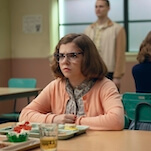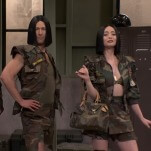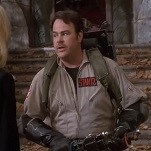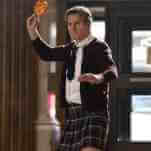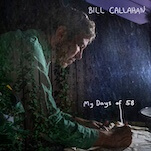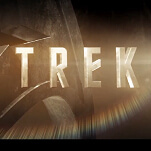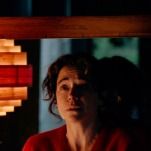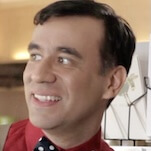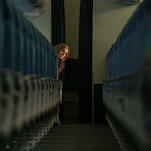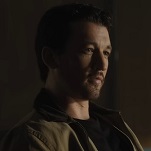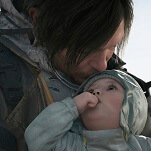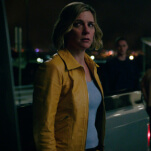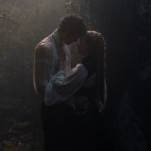Thirty years ago, it was a given that if you saw Quentin Tarantino’s Pulp Fiction in theaters, you eventually bought the soundtrack. From the music to the dialogue snippets to Uma Thurman’s seductive pose on the cover, the triple platinum-selling soundtrack was a cool, take-home companion piece, something to play in your car while you and your friends quote your favorite lines.
The Pulp Fiction soundtrack basically had Tarantino getting his Martin Scorsese on, throwing together a compilation of previously released pop songs with help from music supervisor Karyn Rachtman. They did the same thing on Tarantino’s 1992 debut Reservoir Dogs, rounding up ‘70s oldies to spin over at K-Billy, the fictitious radio station (with an off-camera Steven Wright serving as the station’s DJ) that was the station of choice for that movie’s band of robbers.
Tarantino went one step further with Pulp Fiction, mixing in surf music with the throwback tunes he assembled. Tarantino sets the movie’s boisterous, batshit tone right at the jump, with Dick Dale & His Del-Tones’ crunchy “Misirlou” playing during the opening credits. Then, when the sound of a radio dial switches (which happens right when Rachtman’s name appears on screen), we go into Kool & the Gang’s “Jungle Boogie,” another wild-and-wooly track that hints at the funky chaos to come.
Surf music is a constant throughout this film. Tarantino uses it to score integral scenes, like the stylish montage of John Travolta’s hitman Vincent Vega shooting up heroin and driving at night, all set to The Centurians’ woozy, bluesy “Bullwinkle Part II.” But it also serves as background music, like when The Tornadoes’ “Bustin’ Surfboards” (which includes ocean wave sound effects) is playing in the home of Lance (Eric Stoltz), the heroin dealer Vincent gets his smack from. The craziest surf-rock selection comes when rednecks from a pawn shop take crime boss Marsellus Wallace (Ving Rhames) and on-the-run boxer Butch (Bruce Willis) into a back room—complete with a leather-clad “gimp”—and sodomize Marsellus to the sounds of The Revels’ sax-heavy “Comanche.”
Tarantino has said he originally wanted The Knack’s “My Sharona” for this scene. “‘My Sharona’ has a really good sodomy beat to it, if you think about it,” Tarantino said in an interview. Unfortunately, a member of The Knack objected to the song being used for such a scene. Besides, the song was already, memorably used in the Gen X fave Reality Bites, also supervised by Rachtman, earlier that year. (Side note, both Pulp Fiction and Reality Bites were produced by Jersey Films, Danny DeVito’s production company.)
But this didn’t stop somebody from taking that scene, replacing “Comanche” with “My Sharona,” and posting it on Dailymotion.
Tarantino has said he rounded up surf-rock instrumentals because he thought they were better suited for a “rock-and-roll spaghetti Western,” but I can’t help but think he also did it to get back at California beach bums. In a 1994 BBC documentary on Tarantino, he recommends several films, including John Milius’ coming-of-age surfing dramedy Big Wednesday. While recommending Big Wednesday, Tarantino also throws some shade at the surfers he knew during his formative years in the coastal city of Torrance. “I don’t like surfers,” he said. “I didn’t like them when I was growing up. I lived in a surfing community. I think they were all jerks. I like this movie so much, surfers don’t deserve this movie.” Scoring Pulp Fiction with music geared towards people he despises almost seems like petty cultural appropriation. But, thankfully, it works.
Although Pulp Fiction looks like it’s set in present-day Los Angeles, the music makes it seem like the city never left the ‘70s. When Vincent and his Jheri-curled partner Jules (Samuel L. Jackson) walk through an apartment building to make a morning hit, The Brothers Johnson’s 1977 rendition of Shuggie Otis’ “Strawberry Letter 23” can be heard playing from an apartment they pass. (That song wasn’t released on the original soundtrack, but it did appear as a bonus track on the collector’s edition and on the soundtrack for Tarantino’s next movie, Jackie Brown.) Later on, Tarantino has Dusty Springfield’s 1968 blue-eyed soul hit “Son Of A Preacher Man” playing as Vincent picks up Mia (Thurman, memorably rocking a black Anna Karina wig), his boss’ wife, for a night on the town.
Tarantino goes full-on nostalgic during Vincent and Mia’s “date” to Jack Rabbit Slim’s, a ‘50s-style theme restaurant (“a wax museum with a pulse,” as Vincent calls it), which lays on the surf music (two from the surf-rock icon Link Wray and His Ray Men are heard) as well as tunes from heartthrob Ricky Nelson (who starred in Rio Bravo, one of Tarantino’s favorite films).
Of course, we also get the pleasure of seeing Travolta dance again, as Vincent and Mia twist and Batusi during a dance contest to Chuck Berry’s “You Never Can Tell.”
This leads to another swoony musical moment: Mia back at her place dancing (before accidentally overdosing on Vincent’s heroin, mistaking it for cocaine) to Urge Overkill’s cover of Neil Diamond’s “Girl, You’ll Be a Woman Soon.” From their 1992 Stull EP, the song became a breakout hit for the Chicago alt-rock band, peaking at number 59 on Billboard’s Hot 100 and number 11 on the Modern Rock Tracks Chart.
The most peculiar music cues happen whenever Marsellus and Butch are in the same scene together. We first see the pair in a club, as Marsellus pays Butch to take a fall during a fight. Al Green’s “Let’s Stay Together” is playing, its title practically foreshadowing the brief, unlikely bond these eventual foes instantly forge when they’re bound and ball-gagged in that pawn shop’s back room. The next time Butch sees Marsellus, he hits him with his car to the sounds of The Statler Brothers’ “Flowers On The Wall.” (Right when they lock eyes, “It’s good to see you, I must go.”) And when they bloodily stumble into that pawn shop, Maria McKee’s sorrowful “If Love Is A Red Dress (Hang Me In Rags)” is the background music.
While it may be the most successful, influential soundtrack Quentin Tarantino has put together, Music From The Motion Picture Pulp Fiction seems more like a quaint collection of ditties in comparison to the soundtracks he would curate in later years. His post-Pulp compilations are just like his movies: ambitiously orchestrated, pop culture-drenched Easter-egg hunts, usually full of anachronistic-but-relevant pop songs and music cues from movies and TV shows he admires. The Pulp Fiction soundtrack is more like a mixtape Tarantino made of the tunes he cherished in his geeky/gawky youth, along with music from a community he hates—but that he co-opted anyway to unforgettable effect.



